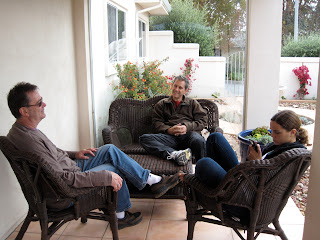 |
| How many burgers does it take to satisfy a couple of Ohio girls? Photo: foodnetwork.co.uk |
I know this affection I have for meat is wrong. The World Watch Institute and the Watch Mom Eat Institute (OK, I made that one up) remind me that livestock emit 16 percent of harmful methane gasses. With meat, the average U.S. diner requires twice as much water per person per day than a vegetarian. A diet high in meat can use two to four times more land--sometimes deforested land--than a vegetarian diet.
 |
| It's just not the same. Photo: wellsphere.com |
I always wanted to be a salad person. One who picks at her food or forgets to eat lunch entirely. But I am a meat person who seldom misses a meal (see profile photo.) Whether it is my upbringing, my palate or sheer stubbornness, I love my burgers.
 |
| Are those tomatoes really necessary? Photo: Nancy'srecipes.com |
 |
| What I eat when I need a break from burgers. |
In this age of conscientious eating, meat has become my vice. Forget the heroin, after my kids move out I am sitting down with a side of beef for a three day burger bender. The smell of pot roast and root vegetables will be thick in the air. I will carve the leftover tofu into the shape of a cow and use it as a centerpiece. Meanwhile, I have taken the following measures as outlined by Progress Report.cancer.gov in their Dietary Guidelines for Americans (DGA.) Who knows, maybe they will become permanent:
Eat meat in moderation
According to the DGA we can eat 18 oz. per week. I was surprised at their generosity, until I realize how large most restaurant portions can be. So, it works out to about one steak and one burger per week. Still, it’s do-able.
Order or buy the best cuts available
Ground meat that you buy in the market is usually clearly marked for cut and fat content. Stick to single source cuts (like round or sirloin) and look for the lowest fat content possible. Also, look for origin; cattle raised on grass produce healthier meat.
Prep properly
Try baking or broiling meat rather than frying or grilling it to avoid the use of additional fats or the potential carcinogenic effects of char.
Leave off the fatty side dishes
Sigh.
 |
| Photo: laughparty.com |
These are good first steps to cutting down on the consumption of meat. As a safeguard, I have my girls and my guilt keep me in line. Oh, I can’t wait for my friend to come back and visit again in the near future. But I guess it would be a good idea to leave those burgers in the past.
 |
| What? It could happen! Photo: alternativeoutfitters.com |
*If you want to read further about monopolies in the beef industry, unsafe food processing and other “turn me vegetarian” topics read the excellent book “Fast Food Nation by Eric Schlosser.






































